September 28, 2007
Air Date: September 28, 2007
FULL SHOW
SEGMENTS
Global Warming on the Global Stage
/ Jeff YoungView the page for this story
From the UN to the White House, world leaders wrestled with the thorniest policy problems on climate change this past week. The message to America: the world is tired of waiting for the U.S. to act. Living on Earth's Jeff Young talks with host Bruce Gellerman. (09:45)
Listener Letters
View the page for this story
Living on Earth dips into the mailbag to hear what listeners have to say. (02:30)
Fencing the Weather
View the page for this story
In an attempt to stop the westward spread of crop-consuming wild rabbits, Australia put a fence across an almost 2,000 mile stretch of the outback. The fence didn’t stop the rabbits, but it’s caused an interesting phenomenon: the weather is different on each side of the fence. Host Bruce Gellerman speaks with Udaysankar S. Nair of the University of Alabama, who conducted research on how land use affects the weather. (04:45)
Happy Birthday Sputnik
View the page for this story
Fifty years ago, Soviet scientists launched Sputnik 1, the first artificial satellite in history. The tiny sphere orbited the globe for just a few months but changed the world forever. Host Bruce Gellerman talks with Roald Sagdeev, director emeritus of the Soviet Institute for Space Research in Moscow. (05:00)
Harvest Cooking
/ Ian GrayView the page for this story
The harvest season is winding down and people's pantries are filling up with the last of the summer's tomatoes, winter squash, carrots and cobs of corn. In this final segment of our series on cooking with CSAs, producer Ian Gray visits his local farm in Granby, Massachusetts with food writer Kathy Gunst for some tips on how to make the produce last through the winter months. (06:30)
Emerging Science Note/ Space Dust
/ Amy FishView the page for this story
Amy Fish reports that space dust may hold the key to life in outer space. (01:30)
The Language of Landscape
/ Eva SaulitisView the page for this story
Living on Earth continues its series with readings from the book “Home Ground: Language for an American Landscape,” edited by Barry Lopez and Debra Gwartney. In this installment, Eva Saulitis, a writer, teacher and marine biologist from Homer, Alaska, explores the term “boreal forest”. (03:10)
Oil or Birds
View the page for this story
The Bureau of Land Management hopes to lease the last untouched part of Alaska’s North Slope to oil and gas drilling companies. Host Bruce Gellerman speaks with Stan Senner, executive director of Audubon Alaska, about Teshekpuk Lake, which is a critical nesting and mating ground for migratory birds and other species, and could soon be developed. (04:30)
Birds of the North Slope
View the page for this story
Gerrit Vyn, a biologist with the Cornell Lab of Ornithology, has just returned from Teshekpuk Lake in Alaska with hours of bird recordings. He tells host Bruce Gellerman about some of the birds he saw, and what stands to be lost if the area is open to oil drilling. (07:50)
This week's EarthEar selection
listen /
download
Under and above water sounds of Glacier Bay, Alaska
Show Credits and Funders
Show Transcript
HOST: Bruce Gellerman
REPORTERS: Jeff Young, Ian Gray
GUESTS: Professor Udaysankar Nair, Professor Roald Sagdeev, Kathy Gunst, Eva Saulitis, Stan Senner, Gerrit Vyn
SCIENCE NOTE: Amy Fish
[THEME]
GELLERMAN: From Public Radio International—this is Living on Earth.
[THEME]
GELLERMAN: I’m Bruce Gellerman. World leaders meet for a week and wrestle with the issue of global climate change, many warning that the time for action is running out.
AHMED: I speak for Bangladesh and many others who are on the threshold of a climatic Armageddon. Climate change is fundamentally altering our lives.
GELLERMAN: But the more things change the more they stay the same. China and the U.S.—the world’s largest producers—refuse to alter their positions on curbing greenhouse gases. Also, billions of barrels of oil or millions of birds? The government wants your opinion on drilling in one of the most sensitive regions of Alaska.
VYN: As soon as an oil company gets a green light, it’s not like it takes them ten years to develop an area. It’s done within a year or two and that area, as far as the wilderness goes, is pretty much lost forever.
GELLERMAN: A former oil consultant now sides with his fine-feathered friends. These stories and more this week on Living on Earth. Stick around!
ANNOUNCER: Support for Living on Earth comes from the National Science Foundation and Stonyfield Farm.
Global Warming on the Global Stage
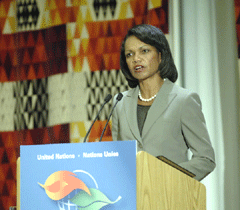
(Courtesy of United Nations)
GELLERMAN: From the Jennifer and Ted Stanley studios in Somerville, Massachusetts—this is Living on Earth. I’m Bruce Gellerman, sitting in for Steve Curwood.
They called it ‘climate week.’ From the White House to the United Nations world leaders met and wrestled with the issue of global warming, asking ‘what’s the best way to curb greenhouse gas emissions?’ and ‘what will it take to get the world’s biggest emitters—China and the United States—to do more to avoid dangerous warming?’ President Bush and UN Secretary General Ban Ki-Moon hosted separate climate events just days apart with an eye toward the next major global conference on climate change in Bali in December. But while most of the world’s leaders agree that climate change is a serious problem, they’re still sharply divided on what to do about it.
Living on Earth’s Jeff Young followed the climate action in New York and Washington, which is where he is right now. Hi, Jeff.
YOUNG: Hi Bruce.
GELLERMAN: Busy week on the climate front but did they make any progress?
YOUNG: Well, the UN event drew more than 80 heads of state, which shows they take this seriously. The White House event, if nothing else, it got China and the U.S. talking. And there are hopes that they’ll keep talking and at the next talks maybe there will be a breakthrough and that would be in Bali.
GELLERMAN: That’s because countries’ commitments to cut CO2 under the Kyoto last only to what—2012, right? That doesn’t leave much time, Jeff.
YOUNG: That’s right, and don’t forget Kyoto also did not place limits on emissions from the bigger developing countries like India and China. And don’t forget the U.S. never ratified Kyoto. And add to that the growing scientific evidence of how rapidly the planet is warming. All of a sudden you see why Bali is so important. People feel they need to get the biggest countries on board and they need to do it fast.
GELLERMAN So, they’re still at a bit of a deadlock then, huh?
YOUNG: Pretty much, yeah.
GELLERMAN: But is the picture more complex than that? Did it seem to you that the warnings from the scientific community are getting through to the political leaders?
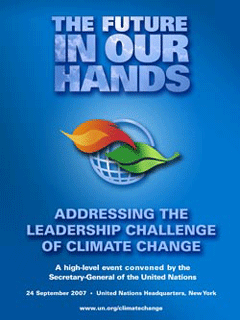
Poster at UN Climate Change Meeting (Photo: United Nations)
AHMED: I speak for Bangladesh and many others who are on the threshold of a climatic Armageddon. Climate change is fundamentally altering our lives. By some estimates, a one meter sea level rise will submerge one third of the total area of Bangladesh, thereby uprooting 25 to 30 million people. We cannot afford to remain idle until this misfortune actually unfolds. Waiting any longer will be at our own peril. I thank you, Mr. Chairman.
[APPLAUSE]
YOUNG: The arid parts of Africa, the small islands, all the less developed nations say they face the greatest threats from climate change and can least afford to deal with them. They want help to adapt to rising seas and drought and they demand that rich nations, especially the U.S., commit to further cuts in greenhouses gasses.
GELLERMAN: But Jeff, the United States opposes mandatory caps.
YOUNG: That’s right. So the U.S. Secretary of State Condoleeza Rice—when she spoke at the UN—emphasized the role of new energy technology.

Secretary of State Rice speaks at UN Climate Change Meeting (Photo: Michael Gross)
RICE: Ultimately, we must develop and bring to market new energy technologies that transcend the current system of fossil fuels, carbon emissions and economic activity. Put simply, the world needs a technological revolution.
YOUNG: Rice plays up the $18 billion the U.S. has spent on clean energy technology under the Bush administration, and she cautions that taking rash action to curb greenhouse gases carries the risk of holding back poor countries.
RICE: And especially for the millions of men, women and children in the developing world whose efforts to escape poverty require broad and sustained economic growth and the energy to fuel it.
YOUNG: So, while Rice said the U.S. is looking to expand its leadership here, it does not look like that means they’re willing to take on any sort of binding commitments.
GELLERMAN: And yet, it’s binding commitments that are exactly what most of the world and environmental groups are saying we need.
YOUNG: That’s right. So, when the President hosted his meeting on climate, environmental groups made sure they were heard loud and clear.
DEMONSTRATORS: No More Hot Air! Clean energy now! [CHANTING CONTINUES]
PASSACANTANDO: This meeting George Bush is holding on global warming is a fraud. It’s designed to prevent any action to stop global warming.
[CHANTING FADES UNDER]
GELLERMAN: So, Jeff, where are we right now?

President Bush addresses U.N. General Assembly
(Photo: US Department of State)
INSLEE: That is one of the vilest canards there is when talking about global warming. Tell the secretary to go to Bangladesh and talk to the millions of people whose land will be underwater. Tell her to go to the Sudan where we have huge conflict in part because we have increased desertification. The no-action option is economic disaster for the developing nations. Maybe we’ll be able to rebuild the shoreline of Manhattan but developing nations are not going to rebuild the shore of Bangladesh.
GELLERMAN: The vilest of canards. Boy….What was the reaction from the other countries that took part in the meeting, Jeff?
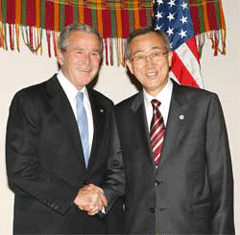
President Bush and UN Secretary-General Ban Ki-moon
(Photo: US Department of State)
YOUNG: Well, European leaders had some applause for the president’s effort to reach out here. But they remain very skeptical about the administration’s voluntary approach to reducing emissions. The Danish Environment Minister Connie Hedegaard argues that it’s not enough to just do the research and development. If you want clean energy, she says, you have to create a market for it. And she says the way to do that is a mandate that will put a price on those carbon emissions.
HEDEGAARD: You cannot just have voluntary goals, you have to have targets. Because we are getting a bit impatient, not on our own behalf but on behalf of the planet because things have to move with a greater speed—that is what science tells us.
YOUNG: I found the politics at work here interesting. The Europeans were clearly trying every angle to press their point. They didn’t just go to the president’s event; they also made very public visits to Congress, where, of course, Democratic leaders are pushing for mandatory caps on carbon emissions. And some of the European officials I spoke with say that gives them leverage when they go to talk with the White House about climate. And also, Bruce, I also got a sense that a lot of the global community is already looking past the Bush administration. They’re hoping they’ll have better luck on this issue with the next person who occupies the White House after the elections.
GELLERMAN: But what about China? I mean, they’re growing like crazy and, depending on who’s counting emissions, China already has or soon is going to pass the United States as the biggest source of CO2. Did you learn anything about where the Chinese see themselves fitting into all this?
YOUNG: Well, of course China and the U.S. have been at a sort of stalemate on this. Neither wants to jeopardize their competitive advantage by, you know, limiting the energy they might consume, or raising the cost of manufacturing. So, it’s kind of like, I see two people standing at an open door and they’re each saying to the other, “oh no, after you.” And this has been going on for what-- ten years?
However, Chinese officials I heard this week say they know that climate change is a serious threat and they insist they are doing things about it—it’s just in their own way. Xie Zhenhua is China’s vice chair for national development. I heard him at an event where he talked about reforestation and energy efficiency, and even family planning as a way to cut CO2.
[XIE SPEAKING MANDARIN]
VOICEOVER: We have avoided the birth of more than 300 million people, which is equivalent to the avoidance of CO2 emissions by 1.3 billion tons. We are trying our best efforts to integrate policy on climate change.
YOUNG: So I heard the Chinese saying they’re willing to do more, but their bottom line does not appear to have moved. And that bottom line is the U.S. and the other developed nations created most of this problem, therefore they’re the ones that need to take most of the action.
GELLERMAN: So, the ball is still firmly in the United States’ court.
YOUNG All eyes are still on the U.S. It’s clear that without leadership from the world’s richest country, the world’s biggest historic greenhouse gas polluter, there’s little chance of bringing the other major polluters on board.
GELLERMAN: Well, thank you very much, Jeff.
YOUNG: You’re welcome.
GELLERMAN: Living on Earth’s Jeff Young reporting on climate week events in New York and Washington, D.C.
Related links:
- UN High Level Event on Climate Change
- White House Meeting of Major Economies on Climate Change
- Hear more of what environmental groups around the world think of the White House climate conference
[MUSIC: Manu Katche “Inside Game” from ‘Playground’ (ECM—2007)]
Listener Letters
[THEME MIX UP AND UNDER]
GELLERMAN: Time now to hear from you, our listeners.
[THEME UP AND FADES UNDER AND OUT]
GELLERMAN: We got an earful about our recent commentary from Gernot Wagner who made the case that energy independence for the United States is not only unachievable, but undesirable.
Wes Tator, who listens to LOE on New Hampshire Public Radio, emailed to say, ‘I thought your speaker was right on.’
But Cat Givens from Portage Lakes, Ohio sent us ‘a resounding yes’ to energy independence. She tunes in to WKSU and writes: ‘The war on terror would be a thing of the past if we close down our dependence on oil and use the energy resources already available to us—like…ethanol, solar, wind, and battery-powered cars. There are green alternatives we can utilize right now.’
Then we got this phone call:
CRANE: What about the long forgotten word ‘conservation’?
GELLERMAN: Diane Crane listens to us in Western Massachusetts.
CRANE: This country is very spoiled and very wasteful. I mean, you know, I see it on the road with gasoline, for instance. People aren’t going 65 miles an hour down the highway. They’re going 75, 85, and, I wager, some are even going 90 miles an hour. Why aren’t they going 55?
GELLERMAN: Maybe people in a hurry just don’t give a hoot. Our story about barn owls as road kill prompted Leslie from Hatboro, PA to write that she’s noticed something odd lately: ‘Hawks sit in trees near the highways,’ she says, ‘It dawned on me these birds are waiting to grab fresh road kill. How ingenious. Did individual birds invent a new way of hunting, all on their own or is this a species wide change in behavior?’
We got another question, this one from Julie Marie Ford in response to our story by our Washington correspondent, Jeff Young, in which he compared his use of water to that of a woman in rural India.
Ms. Ford asks, ‘Has anyone thought to market a bottled water where all of the proceeds go directly to programs to fund water stations in third world countries? This would have a direct effect on helping other people and change the world.’
What do you think? Let us know your thoughts about what you hear on Living on Earth. Our email address is comments@loe.org. Once again that’s comments at L-O-E dot O-R-G. Or put a stamp on it and send it to 20 Holland Street, Somerville, Massachusetts, 02144. And there’s always our listener line at 800-2-1-8-9-9-8-8. That's 800-2-1-8-99-88.
[THEME MUSIC UP AND OUT]
GELLERMAN: Coming up: why the grass isn’t always greener on the other side of the fence. Keep listening to Living on Earth.
[MUSIC: Rudder “Squarefoot” from ‘Rudder’ (19/8 Records—2007)]
Fencing the Weather
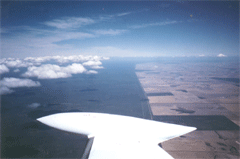
Aerial view of clouds forming over native vegetation (Photo: Udaysankar S. Nair)
[MUSIC: Bugs Bunny in “What’s Opera Doc” (Looney Tunes/Warner Bros.—1954)]
GELLERMAN: It’s Living on Earth. I’m Bruce Gellerman.
[ELMER FUDD SAYING ‘WABBIT TWAPS’]
GELLERMAN: Back in 1907, wabbits—uh, rabbits—were invading western Australia.
The government decided the bunnies had to go.
[ELMER FUDD SINGING: ‘KILL DA WABBIT, KILL DA WABBIT, KILL DA WABBIT!’]
GELLERMAN: Instead of killing the rabbits, Australia decided to build a bunny
Fence--- 2,000 miles long to keep the rabbits out of the outback. The fence didn’t work but scientists began noticing something strange: on the side of the fence where farmers planted crops there were fewer clouds and it rained a lot less than the side that had native vegetation. The effect the bunny fence had on weather has baffled researchers, until now.
Udaysankar Nair of the University of Alabama in Huntsville is in western Australia where he’s investigating the fence phenomena. Thanks for joining us, professor.
NAIR: You’re welcome.
GELLERMAN: I’m looking at a photo that’s in your research paper. It was taken of the fence from an airplane and the image is really dramatic. Right down the fence line on the left side it’s very dark and there are clouds over the field. And then on the right side of the fence there’s not a single cloud. That’s the farmed land. Why is that?

Aerial view of clouds forming over native vegetation (Photo: Udaysankar S. Nair)
GELLERMAN: And the farmed side is lighter in color so it’s not absorbing the radiation, it’s just bouncing back into the atmosphere.
NAIR: It is not absorbing as much. It is actually absorbing the radiation but it’s slightly less than what’s being absorbed on the other side.
GELLERMAN: So, it’s not the fence. It’s what we do with the land that can affect the weather.
NAIR: Yes. What’s happening here is the fence is a barrier that demarcates between these two areas. And you know you can see that from space.
GELLERMAN: So Dr. Nair are you seeing this effect anywhere else on the planet?
NAIR: Yes, we have been researching deforestation in Costa Rica. And what we found out was that in upwind locations of mountains when you deforest the air going up into the mountains are more dry and more warm. What this implies is that there is less water available for cloud forest for example in Monte Verde. And another region where this might have an impact is for example Kilimanjaro where there have been recent concerns about glaciers melting. And this could also have an impact in such regions because when you deforest lowlands the air going up the mountains are going to be altered and it could be more dry and more warm.
GELLERMAN: So the farmers around Mt. Kilimanjaro could actually be leading to the shrinkage of the snow cover of the mountain.
NAIR: Yes, they could be contributing to the effects that are being seen in Kilimanjaro now.
GELLERMAN: I’m wondering what the implications of your research would be here in the United States. You know farmers are being told to plant corn for ethanol from fence post to fence post.
NAIR: One of the interesting questions that this study raises is that when you clear more and more areas for farming—would you reach a point where you clear too much land that you are going to reduce the rainfall and you get to a point of diminishing returns?
GELLERMAN: Dr. Nair, how is the weather there by the way?
NAIR: It was actually really nice today. It was very warm. It’s actually been cold for the last couple of days and it has really warmed up today.
GELLERMAN: Which side of the fence are you on?
NAIR: Actually we are staying on the agricultural side but we also have a site that’s set up on the native vegetation area.
GELLERMAN: So are there clouds over the agricultural side?
NAIR: Actually today we found clouds that formed over the native vegetation area early in the morning and it stayed that way until about the afternoon. So, clouds were preferentially forming over the native vegetation area today in the morning.
GELLERMAN: So, it’s consistent with your research.
NAIR: Yes, we saw what we were looking for today so that was very good.
GELLERMAN: Udaysankar Nair is a research scientist in the Earth System Science Center at the University of Alabama in Huntsville. He joined us from the Lake King area in southwest Australia. Dr. Nair, thanks a lot. Enjoy the weather.
NAIR: I definitely will.
Related link:
For a summary of the findings along the rabbit-proof fence, click here.
Happy Birthday Sputnik
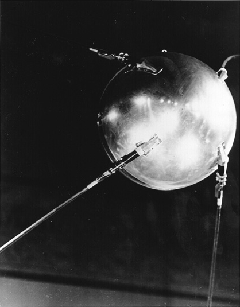
Sputnik (Courtesy of the State of Indiana)
[BEEPING SOUND]
GELLERMAN: On October 4th 1957, this sound marked a new era in space science.
And set off alarms in the United States. It was fifty years ago, that the Soviet Union launched Sputnik 1. It was the world’s first artificial satellite. The tiny aluminum sphere with four whisker-like antennas sent the beep-beep-beep signals that were picked up by ham radio operators around the planet. Joining me to discuss Sputnik 1 is Roald Sagdeev, Director Emeritus of the Soviet Institute for Space Research in Moscow. Professor Sagdeev, it’s a real pleasure.
SAGDEEV: I’m happy to be part of your program.
GELLERMAN: What does Sputnik mean?
SAGDEEV: You mean the meaning of the word ‘sputnik’ in Russian language?
GELLERMAN: Yes.
SAGDEEV: Its literal translation is ‘travel companion.’
GELLERMAN: What was the significance of Sputnik in your mind?
SAGDEEV: It depends on what a particular person is doing. I’m a scientist so I’m really impressed with completely new horizons opened for scientists. It started with the possibility to study what’s happening above atmosphere, then the moon; solar system. And astronomers suddenly discovered that the sky as a universe in a completely new different way. And in the end, with all of these new discoveries, the basic fundamental physics was enriched tremendously.
GELLERMAN: We responded by starting a space-race and I’m wondering was the Soviet Union in the race, too?
SAGDEEV: You know, I think first of all it was a missile race. And then when space spectaculars became so much influential—impressive, you know, for the rest of the world—then both countries suddenly found themselves in competition of who would provide more spectacular firework in space.
GELLERMAN: I found it interesting that the rocket that was used to launch Sputnik, the R7, is still being used by Russians today.

Sputnik (Courtesy of the State of Indiana)
GELLERMAN: What about the Russian space program now?
SAGDEEV: First of all what happened, the overall budget for space program shrank tremendously. If I said ten times it would not be overestimation. So, much fewer launches and very few new technological developments. And the second thing which is happening—Russia is trying to sell whatever it inherited from Soviets—same Soyuz rockets, descendants of R7, is one of the objects in trade also. And also some other launchers.
GELLERMAN: So Professor Sagdeev, how are you going to commemorate Sputnik 1?
SAGDEEV: I will go back to Moscow for a few days and there is a big conference organized by my former institute of Space Research in Moscow. I served as the director for 15 years. And it will be a big international gathering so we will see what we have learned over the period of 50 years and try to figure out what’s going to happen in future.
GELLERMAN: Well professor I want to thank you very much.
SAGDEEV: Thank you for your interest.
GELLERMAN: Today, Roald Sagdeev is a distinguished professor of physics at the University of Maryland. Well 50 years ago in 1957, Wham-O produced the first Frisbee. Ford introduced the Edsel. The “Cat in the Hat” was published. Velcro was patented. The first bucket of Kentucky Fried Chicken was sold. And while Sputnik was spinning the globe, this 45 was spinning to the top of the charts.
[MUSIC: Jerry Lee Lewis “Great Balls Of Fire” from ‘Jerry Lee’s Greatest’ (Sun Records—1961)]
Harvest Cooking
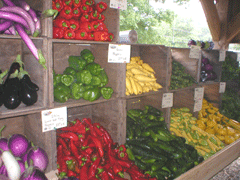
Red Fire Farm's local produce at market. (Photo: Red Fire Farm)
GELLERMAN: Well, it’s that time of year again. The harvest season is winding down and people are gearing up for winter, stocking their pantries with the last picks of the season—tomatoes, squash, carrots and cobs of corn. The culinary challenge: to make the fresh, locally grown summer produce last through the long, cold months ahead.
Living on Earth producer Ian Gray has been watching this year’s harvest. He’s a member of a CSA, a Community Supported Agriculture at Red Fire Farm, where every week he gets his share of the farm’s bounty. Food writer Kathy Gunst has been joining Ian as he collects his produce and showing him creative ways to cook it. In the final installment of our series, Ian and Kathy traveled to Granby, Massachusetts where they met Red Fire Farm’s Ryan Voiland.
[SOUNDS OF WALKING OUTDOORS]
GUNST: Could you tell us a little bit about Red Fire Farm? How long has this land been farmed and . . . ?
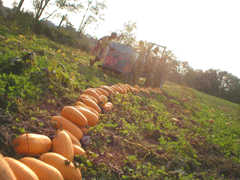
(Courtesy of Red Fire Farm)
GUNST: I can’t help but notice this is a fairly suburban neighborhood and here you have this sort of bucolic rural farm next to house, house, house. Have you really saved a big track of land I would think?
VOILAND: That’s true. I think the situation with the land here is typical of much of New England in that we have suburbanization encroaching from all directions and farmland is the easiest land to develop for developers who want to build houses. Usually farmland is well drained so it’s easy to put in a septic system. I think it’s really a tragedy and pretty shortsighted for planners, that we allow all of our good farmland to get carved up.
GUNST: So now that you’re winding down the seventh growing season—how is it going? How’s the CSA? I mean, are you on target?

(Courtesy of Red Fire Farm)
GUNST: Tell us again how many families you’re feeding through the CSA.
VOILAND: The CSA is, we sell about 500 shares. Some of those shares go to families- are split between-, people use them in different ways.
GUNST: Five hundred families is really impressive.
VOILAND: It’s quite a bit of food. It’s definitely quite a bit of food.

Radishes at Red Fire Farm (Courtesy of Red Fire Farm)
VOILAND: We’re at the farmhouse where much of the farm crew lives, including myself. And we’re going to let you use the kitchen and cook something up with the produce that we collected.
[MUSIC: Beastie Boys “Sabrosa” (Sounds of Science—2000)]
GRAY: Alright, now to work, right?
GUNST: I mean this is just a joy because these are such gorgeous vegetables. What I’ve discovered is that you can make just a fabulous sauce, in this case a tomato sauce, using all of his onions and garlic and herbs from the garden and you can roast it at a really high temperature. There’s no peeling. There’s no seeding. No fuss no muss.
[MUSIC: Beastie Boys “Sabrosa” (Sounds of Science—2000)]
GUNST: We’re going to take all of these different tomatoes. We have the Brandywine, the Germans, the yellows, the green stripe and we’re just going to chop them up. We’re going to take the core out. And you want to just chop the tomatoes up into I don’t know—one-inch pieces—but again, it doesn’t matter because the high heat’s going to break it down. I’ve got a big roasting pan. Anything you’ve got you can use; ovenproof skillets. The other great thing about this sauce is you can make this with three tomatoes. You can just make up a bunch of sauces.

Red Fire Farm's local produce at market
(Courtesy of Red Fire Farm)
GUNST: Exactly. You can just pop it into a bowl and keep it in the refrigerator or you can stick it in a plastic bag and put it in your freezer.
GRAY: So, I’m looking at a lot of these tomatoes that we picked. They’re actually kind of cracked and a little bit gnarled on the top and they’re black and bruised a little bit. They’re not the best tomatoes from the field.
GUNST: But when you cut the tomato open look at the inside. I mean it’s perfect. It’s juicy. I mean the flesh is just gorgeous. So don’t worry. Looks can be deceptive.
GRAY: We’ve got our tomatoes finished up here so you’re going to start in on onions in a second.
GUNST: Oh, I’d say we have about; oh I’d say eight pounds of tomatoes in there. And now I’m going to take an onion and again—just coarsely chop. It doesn’t have to be precise.
[CHOPPING SOUNDS]
GUNST: Okay. And we’re going to onion and garlic and some fresh herbs. I’m just going to sprinkle the onions on top of the tomatoes. We’re going to drizzle it with a little bit of olive oil. And decent olive oil would really pay off here. We just want to lightly coat it, maybe about a quarter of a cup. Again, it depends on how much sauce you’re making. Some salt and pepper. And then we picked a beautiful head of basil. We’ll add some of that chopped up. A little salt and pepper, give it a stir. It looks like gazpacho. Look at this, it’s a beautiful tomato salad or soup at this point. Okay we’re going to pop that into our 450-degree oven and we’re not going to touch it.
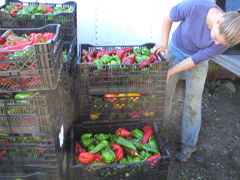
(Courtesy of Red Fire Farm)
GUNST: Alrighty, it has been about an hour and ten minutes and our sauce has thickened up just a bit.
GRAY: And the smells are just flying out of this oven. Oh my.
GUNST: So, we’re going to take this out of the oven and we have got roasted tomato sauce. Let’s turn that oven off. And what we’re going to do is taste it for seasoning. We’re going to adjust with salt and pepper. You could add some chili flakes or tobacco sauce to give it a little bit of a kick. And then we’re going to let it cool.
GRAY: Great. Well, I can’t wait to put this away and then forget about it for a while and then . . .
GUNST: Well, you could have a little of it tonight. But really the real treat of this is that you haven’t spent an entire weekend canning but you still have all the flavors of the harvest waiting for you all winter long.
[MUSIC: Beastie Boys “Sabrosa” (Sounds of Science—2000)]
GELLERMAN: Food writer Kathy Gunst’s latest book is “Stonewall Kitchen Favorites.”
To get the recipe for quick roasted tomato sauce, check out our website, loe dot org. Our local farm cooking segment was produced by Ian Gray.
Related links:
- Roasted Tomato Sauce Recipe
- Kathy Gunst's Website
- Find a CSA near you
- USDA's website on CSAs
- Red Fire Farm
GELLERMAN: Just ahead: will petroleum companies put a damper on birds’ party central in Alaska’s North Slope? First this Note on Emerging Science from Amy Fish.
Emerging Science Note/ Space Dust
GELLERMAN: Just ahead: will petroleum companies put a damper on birds’ party central in Alaska’s North Slope? First this Note on Emerging Science from Amy Fish.
[THEME]
FISH: Ashes to ashes, dust to dust. That’s what the Book of Common Prayer says about life on earth. Now scientists say, this same message may be a hint to life in outer space.
[THEME]
FISH: Scientists from Russia, Germany, and Australia have discovered the surprisingly life-like qualities of an inorganic substance called plasma dust. As the name suggests, the dust is found in plasma—a fourth state of matter so super-hot, its atoms have broken apart. Plasmas are found in stars and outer space. The researchers say that the solid, electrically charged particles of plasma dust seem to act a lot like DNA—a building block of life here on earth.
Inside a plasma, the dust can form corkscrew structures similar to a DNA double helix. And just like DNA, the dust structures can replicate: they divide to make two copies of the original. They can even evolve. It’s sort of an inorganic version of survival of the fittest. The strongest shapes take in surrounding dust particles and reproduce, while the weaker ones die off.
Until now, researchers have looked for extraterrestrial life based only on organic carbon compounds. But this life-like dust contains no carbon.
So, there may be life out there after all—just not as we know it. That’s this week’s note on Emerging Science. I’m Amy Fish.
GELLERMAN: And you’re listening to Living on Earth.
ANNOUNCER: Support for the environmental health desk at Living on Earth comes from the Cedar Tree Foundation. Support also comes from the Richard and Rhoda Goldman Fund for coverage of population and the environment. This is Living on Earth on PRI, Public Radio International.
The Language of Landscape
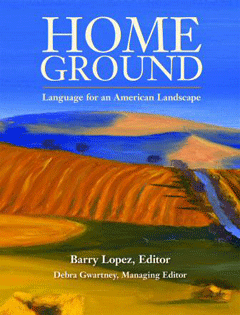
Home Ground: Language for an American Landscape, edited by Barry Lopez and Debra Gwartney.(Photo: Trinity University Press)
GELLERMAN: It’s Living on Earth. I’m Bruce Gellerman.
[MUSIC: Daniel Lanois “O’Marie” from ‘Acadie’ (Daniellanois.com—2005)]
GELLERMAN: Imagine a landscape of a place you love. Follow the forms and the contours in your eye’s mind. Now, put yourself in the picture. To know a place, to truly know a place is a way of making it our own.
Writers Barry Lopez and Debra Gwartney asked 45 authors to describe features of different landscapes. The definitions are part of a collection found in the book called "Home Ground - Language for an American Landscape." We've asked several writers to read from their entries. Today, Eva Saulitis of Homer, Alaska and her definition of ‘boreal forest.’
SAULITIS: Boreal Forest. South of the treeless, Arctic tundra, a forest shawl wraps eleven percent of the Earth’s northern terrestrial surface. This circumpolar boreal forest is white spruce-dominated, carpeted with lichens, moss, orchids, heaths, quilted with peat bogs, and cut by cold, silty rivers. In Crossing Open Ground, Barry Lopez describes one view of this landscape: “a backdrop of hills: open country recovering from an old fire, dark islands of spruce in an ocean of Labrador tea, lowbush cranberry, fireweed…each species of leaf the invention of a different green: lime, moss, forest, jade.”

Home Ground: Language for an American Landscape, edited by Barry Lopez and Debra Gwartney.
(Photo: Trinity University Press)
Indigenous people, to this day, rely on an intimate knowledge of geography to subsist on these animals and plants. Some non-Natives also pursue this intimate geographic knowledge of the boreal forest. For several years, the poet John Haines homesteaded in the boreal forest south of Fairbanks, Alaska, hunting and trapping for subsistence, receiving the forest’s spiritual and artistic sustenance. Of this time Haines wrote, “I am living out a dream in these woods. Old dreams of the Far North.”
GELLERMAN: Eva Saulitis is a writer, teacher and marine biologist from Homer, Alaska. Her definition of ‘boreal forest’ appears in the book “Home Ground - Language for an American Landscape,” edited by Barry Lopez and Deborah Gwartney.
Related link:
Home Ground: Language for an American Landscape
Oil or Birds
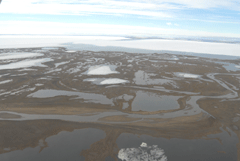
The wetlands around Teshekpuk Lake are among the most important in the Arctic and attract millions of migratory birds. (Photo: Steve Zack/Wildlife Conservation Society)
GELLERMAN: Alaska is also where you’ll find Teshekpuk Lake. It’s on the North Slope 300 miles above the Arctic Circle, and it’s famous for two things: One is oil; the other: birds. It’s got a lot of both. Teshekpuk Lake lies in the National Petroleum Reserve –where it’s estimated there are two billion barrels of oil buried beneath the freshwater lake and marshy wetlands. It’s enough oil to fuel the U.S. economy for three months. As for birds—according to one expert—"it’s got a million of ‘em." In the spring, when the frozen Arctic wetlands begin to thaw, things really heat up as migratory waterfowl turn Teshekpuk Lake into party central. So far, the area is protected and the petroleum off-limits to drilling, but the Bush administration wants to lease the lake to oil companies.
The Bureau of Land Management—under federal court order—recently issued a report on drilling in the area and the agency is now accepting public comments. Stan Senner, executive director for Audubon Alaska in Anchorage, has visited Teshekpuk Lake many times.
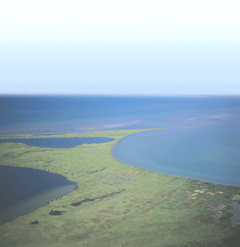
Teshekpuk Lake is in the northeastern part of the National Petroleum Reserve-Alaska.
(Photo: Gary Braasch/Audubon Alaska)
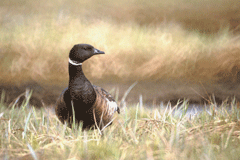
As many as thirty percent of the small geese known as Brant in the Pacific flyway gather near Teshekpuk Lake in summer to molt. While molting the birds are flightless and easily disturbed. (Photo: Tim Bowman/US Fish and Wildlife Service)
GELLERMAN: Some people are going to think, you know—there’s oil, there’s gas there and there’s birds. I’m getting my oil from the Middle East and Iraq and it’s troubled and people are dying there. You know on balance—I need my oil. And well, maybe that’s not such a bad thing. Okay, so we lose the birds.
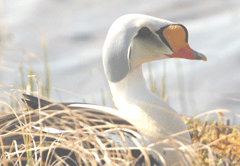
The King Eider nests in high densities near Teshekpuk Lake, and is an important subsistence food for Alaska Natives on the North Slope.
(Photo: Steve Zack/Wildlife Conservation Society)
GELLERMAN: Have you ever seen bird behavior changed around the developments on the North Slope?

The wetlands around Teshekpuk Lake are among the most important in the Arctic and attract millions of migratory birds. (Steve Zack/Wildlife Conservation Society)
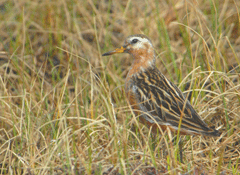
Red Phalarope nests and young are vulnerable to predation by gulls, ravens, foxes and grizzlies attracted to oilfields. (Steve Zack/Wildlife Conservation Society)
SENNER: Well, what we usually see is when birds are displaced out of a prime nesting area it ultimately results in a smaller population and so this idea- that if they’re pushed out of one place and that they have the chance to go somewhere else- doesn’t really hold water. The geese for example, that use the area north of the lake for their annual molt, which is to replace their feathers, they’ve been coming there for many many hundreds or thousands of years. If they’re not able to go there they just may not be returning at all in the future.
GELLERMAN: Well, Mr. Senner, thank you very much.
SENNER: You’re welcome. I’m glad to be here.
Related links:
- National Audubon Society: Alaska
- Bureau of Land Management: Alaska Seeks Public Comments for Draft Supplemental Plan for Northeast NPR-A
Birds of the North Slope

Red-Throated Loon (Photo: Gerrit Vyn)
[BIRD CALLS]
GELLERMAN: And this is what Teshekpuk lake sounds like during the frenetic mating season. These birds were recorded by Gerrit Vyn, a biologist who used to conduct bird population surveys for oil companies that hoped to drill in the area. Now, he’s in Ithaca, New York, with the Cornell Lab of Ornithology.
VYN: The Cornell Lab of Ornithology holds the Macaulay Library, which has a collection, which is the largest in the world of natural history recordings. Over the last few years we’ve been trying to find out just what parts of the collection need to be worked on. And the first thing that came to mind was Arctic Alaska mainly because of the impending threats of both global warming and oil development that are threatening that area.
GELLERMAN: So you wanted to get these recordings while the recording was good?
VYN: Absolutely. A lot of noise comes with oil development and trying to record audio anywhere in the United States is a difficult thing to do with anthropogenic noise, air traffic, car traffic, all that sort of thing. So getting into these areas before the oil companies did to record some of these special places for the future.
GELLERMAN: Well let’s listen to the red-throated loons.
VYN: All right.
[RED-THROATED LOONS SOUNDS]

Red-Throated Loon (Gerrit Vyn)
GELLERMAN: Sounds absolutely miserable.
VYN: (laughs) Well, it’s a challenge, you know. You’re in an amazingly beautiful wilderness and you have a goal and you’re out there trying to get the best kind of audio that you can get. And so when it works out it’s all worth it.
GELLERMAN: How is the area, the North Slope, different from when you were there surveying for oil companies?
VYN: Well, the thing that’s the most shocking, the last time I was up on the Colville River Delta, which is a very important area for both wildlife and subsistence, we were surveying the delta for birds. I went back in 2006 and already the oil companies had put a huge airstrip across the middle of the delta; a big drilling pad. The amount of infrastructure up there to pump oil is mind-blowing. When you fly over it it’s just a massive industrial zone. And it occurs overnight. It really does. As soon as an oil company gets a green light it’s not like it takes them ten years to develop an area. It’s done within a year or two. And that area—as far as wilderness goes—is pretty much lost forever.
GELLERMAN: Well, I guess it was a good thing that these oil companies are trying to do surveys of these bird populations. You were involved in that.
VYN: Well, they are required by law to do these surveys. It’s good to have people up there surveying that care about what they are surveying, but really it’s just a formality that needs to take place before they can go in and develop an area.
GELLERMAN: Let’s listen to another recording we have that you made. It’s a semipalmated sandpiper. Did I get that right?
VYN: That’s right.
[SEMIPALMATED SANDPIPER SOUNDS]
GELLERMAN: Oooh, that will go right through you.
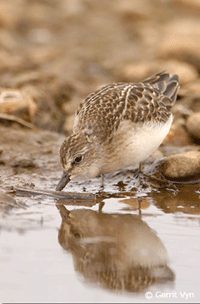
The semi-palmated sandpiper (Photo: Gerrit Vyn)
GELLERMAN: It sounds like you like all the birds. Do you have a favorite?
VYN: Um, I really love the yellow-billed loon, as far as birds go up there. It’s an amazingly beautiful bird and one who could be threatened in the near future. Eighty percent of its population in the United States occurs in the National Petroleum Reserve.
GELLERMAN: Let’s give a listen.
[YELLOW-BILLED LOON SOUNDS]
GELLERMAN: So, what are we hearing there?
VYN: This is similar to the red-throated loon recording we heard earlier. This is a pair announcing its territory on a lake just south of Teshekpuk Lake in the Teshekpuk Lake Special Area. Towards the end of the recording, there you hear the yodel which is the loudest of the yellow-billed loon’s calls. And this big robust loon, it’s a beautiful bird, black and white markings, black and white checkered back with an enormous yellow bill. It will lean its neck forward and just belt out this yodel call. And that call can be heard for miles on the tundra and like the red-throated loons, other yellow bills from neighboring lakes will respond with calls of their own.
GELLERMAN: Can you do bird calls?
VYN: Uh, not in public.
[BOTH LAUGH]
GELLERMAN: Ok, I won’t ask you then. Except, maybe just one?
VYN: Ah, what could I do? No, I can’t do any bird calls.
GELLERMAN: Well, if you go to our web page loe.org you won't hear bird calls from Gerrit Vyn of the Cornell Lab of Ornithology, but you’ll find a link where you can listen to recordings of the real thing from his most recent trip to Alaska.
[SOUNDS OF BIRD CALLS]
Related links:
- To see Gerrit Vyn’s travellog website, click here
- Cornell Lab of Ornithology
[MUSIC: Laurie Anderson “Excellent Birds” from ‘Mister Heartbreak’ (Warner—1984)]
GELLERMAN: Next time on Living on Earth.
[BASEBALL BAT HITTING A BALL]
GELLERMAN: At Boston’s Fenway Park, you can buy me some peanuts and crackerjacks, but in the future, the Sox hope locally grown organic produce and solar energy will also be a hit.
DEE: We want to be on the cutting edge within professional sports to take the lead on this very important environmental and social issue and we think there’s a great opportunity not only to set the standard for sport facilities but the standard for the country in taking this under our wing.
GELLERMAN: The Red Sox go green, next week on Living on Earth.
[SOUND OF WHALE CALLS AND WATER]
GELLERMAN: We leave you this week in—and under—Alaska’s Glacier Bay National Park. Bernie Krause of WildSanctuary.com set his microphones above and below the water and mixed it all together for his CD ‘Whales, Wolves & Eagles of Glacier Bay.’
[MUSIC: Bernie Krause “Whales, Wolves & Eagles Of Glacier Bay” from ‘Whales, Wolves & Eagles Of Glacier Bay’ (North Sound—1994)]
GELLERMAN: Living on Earth is produced by the World Media Foundation. Our crew includes Ashley Ahearn, Eileen Bolinsky, Ingrid Lobet, Emily Taylor, and Jeff Young - with help from Bobby Bascomb, and Kelley Cronin. Our interns are Alexandra Gutierrez and Mitra Taj.
Jeff Turton is our technical director. This week, we say ‘so long’ and ‘good luck’ to our associate producer, Ian Gray, who combined his passion for the environment with a keen intellect and a creative curiosity. Ian, we’ll miss you. Alison Lirish Dean composed our themes. Our Executive Producer is Steve Curwood. You can find us at LOE dot org. I’m Bruce Gellerman. Thanks for listening.
ANNOUNCER: Funding for Living on Earth comes from the National Science Foundation: supporting coverage of emerging science. And Stonyfield Farm: organic yogurt and smoothies. Stonyfield pays its farmers not to use artificial growth hormones on their cows. Details at Stonyfield.com. Support also comes from you our listeners, the Ford Foundation, the Wellbourne Ecology Fund, and Pax World Mutual Funds; socially and environmentally sustainable investing. Pax World: for tomorrow. On the Web at PaxWorld.com.
ANNOUNCER 2: PRI. Public Radio International.
Living on Earth wants to hear from you!
Living on Earth
62 Calef Highway, Suite 212
Lee, NH 03861
Telephone: 617-287-4121
E-mail: comments@loe.org
Newsletter [Click here]
Donate to Living on Earth!
Living on Earth is an independent media program and relies entirely on contributions from listeners and institutions supporting public service. Please donate now to preserve an independent environmental voice.
NewsletterLiving on Earth offers a weekly delivery of the show's rundown to your mailbox. Sign up for our newsletter today!
 Sailors For The Sea: Be the change you want to sea.
Sailors For The Sea: Be the change you want to sea.
 The Grantham Foundation for the Protection of the Environment: Committed to protecting and improving the health of the global environment.
The Grantham Foundation for the Protection of the Environment: Committed to protecting and improving the health of the global environment.
 Contribute to Living on Earth and receive, as our gift to you, an archival print of one of Mark Seth Lender's extraordinary wildlife photographs. Follow the link to see Mark's current collection of photographs.
Contribute to Living on Earth and receive, as our gift to you, an archival print of one of Mark Seth Lender's extraordinary wildlife photographs. Follow the link to see Mark's current collection of photographs.
 Buy a signed copy of Mark Seth Lender's book Smeagull the Seagull & support Living on Earth
Buy a signed copy of Mark Seth Lender's book Smeagull the Seagull & support Living on Earth

